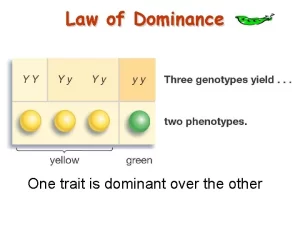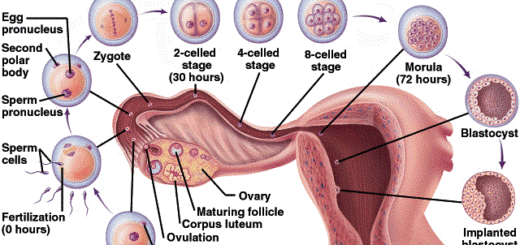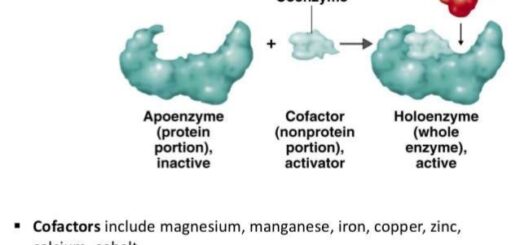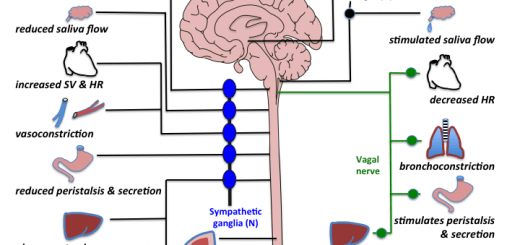Mendel’s laws of heredity, Law of segregation of factors, Dominant trait and Recessive trait
Mendel’s first law is known as the law of segregation of factors due to the segregation of the two factors of a hereditary trait from each other during the formation of gametes. The recessive trait is always pure because it doesn’t appear unless the two genes of the recessive trait aggregate.
Mendel’s assumptions to explain the results of his experiments
Mendel put several assumptions to explain the results he obtained through the experiments of the pea plant, as follows:
- The hereditary traits are transmitted from the parents to the offspring by means of hereditary factors carried by Gametes.
- Each hereditary trait is controlled by two hereditary factors, one from the father and the other from the mother.
- The two hereditary factors of each trait separate when the gametes are formed. where each gamete carries only one factor from these two factors.
- During the fertilization process, the two hereditary factors aggregate again. If the two factors are: Similar (or homozygous), so the produced trait (Dominant or Recessive) is pure and the individual that carries this trait is called a pure individual. Different (or heterozygous), so the produced trait (Dominant) is impure and the individual that carries this trait is called a Hybrid individual.
Dominant factor + Dominant factor ⇒ Pure dominant trait
Recessive factor + Recessive factor ⇒ Pure recessive trait
Dominant factor + Recessive factor ⇒ Impure dominant trait
Application on the seeds colour trait of peas
The trait colour of seeds of pea plant transmitted from one generation to another by means of hereditary factors carried by Gametes [pollen grains & ovules]. The colour of the seeds is controlled by two hereditary factors, one determines the yellow colour and other determines the green colour. The two factors of the colour of the seeds are separated when the formation of gametes. where each gamete (pollen grain or ovum) carries only one factor from these two factors.
When aggregation:
- The yellow colour factor of seeds (dominant) with the yellow colour factor of seeds (dominant), the result are: plants with pare yellow seeds.
- The green colour factor of seeds (recessive) with the green colour factor of seeds (recessive), the result is: plants with pure green seeds.
When aggregation: The yellow colour factor of seeds (dominant) with the green colour factor of seeds (recessive), the result is: plants with Impure yellow seeds, as a result of the yellow colour factor of seeds dominates over the green colour factor of seeds.
Law of segregation of factors
Gametes: The cells by which the hereditary traits are transmitted from parents to offspring. Mendel summarized the previous assumptions in his first law, which is known as the law of segregation of factors to segregate (separate) the two factors of the trait from each other during the formation of gametes.
Law of segregation of factors (Mendel’s first law): When two pure individuals of any one pair of hereditary traits are different from each other. only the dominant trait appears in the first generation, while the two traits appear in the second generation at a ratio of 3 (dominant trait): 1 (recessive trait).
Segregation (separation) of factors occurs during the formation of gametes in meiosis. The Danish scientist Johansen used the term gene instead of the hereditary factor and also he introduced the term “genotype” for the gene structure in the living organism. The term “phenotype” for the hereditary trait that appears on the living organism.
- A dominant gene is a gene whose trait appears when it exists with a similar dominant gene or with a recessive gene for the same trait.
- A dominant trait is a trait that appears when aggregation of two similar factors (two genes) of the dominant trait, or one factor (gene) of the dominant trait with a factor (gene) of the recessive trait.
- A recessive gene is a gene whose trait appears only when it exists with a similar recessive gene for the same trait.
- A recessive trait is a trait that appears only when aggregation of two similar factors (two genes) of the recessive trait.
Dominant gene + Dominant gene ⇒ Pure dominant trait
Dominant gene + Recessive gene ⇒ Impure dominant trait
Recessive gene + Recessive gene ⇒ Pure recessive trait
What happens when…?
The presence of a dominant gene for one of the traits with a recessive gene for the same trait. The dominant gene dominates over the recessive gene, so the dominant trait appears.
Comparison between the dominant trait and the recessive trait
A dominant trait is the that appears when aggregation of two similar factors (two genes) of the dominant trait, or one factor (gene) of the dominant trait with a factor (gene) of the recessive trait. The ratio of its appearance on mating an individual carries a pure dominant trait with another carries a recessive trait: It appears at a percentage of 100% in the first generation and at a ratio of 75% in the second generation. It is pure or hybrid. Example: The trait of yellow colour seeds of peas.
A recessive trait is a trait that appears only when aggregation of two similar factors (two genes) of the recessive trait. The ratio of its appearance on mating an individual carries a pure dominant trait with another carries a recessive trait: It disappears in the first generation and appears at a percentage of 25% in the second generation. It is always pure. Example: The trait of green colour seeds of peas.
Accordingly, the pure individual and the hybrid individual can be defined as follows:
Pure individual is the individual that carries a similar pair of genes (factors) either dominant trait or recessive trait, so the dominant trait (pure) or the recessive trait appears on the individual.
Hybrid individual is the individual that carries a different pair of genes (factors), one is dominant and the other is recessive, so the dominant trait (impure) appears on the individual.
Using symbols to represent the experiments of heredity
To facilitate the process of studying the transmission of hereditary (genetic) traits from one generation to another, the following symbols and terms are used:
- Male individual: ♂
- Mating: X
- Female individual: ♀
- Parents: P
- Gametes: G
- First-generation: F1
- Second generation: F2
The two factors of pure hereditary trait are symbolized by two similar letters, often representing the first letter of the name of the dominant trait in the English language, where: The dominant trait is represented by a capital letter. The recessive trait is represented by a small letter.
So, The genetic structure of pure dominant individual is symbolized by two capital letters. The genetic structure of the recessive individual is symbolized by two small letters. The genetic structure of a hybrid dominant individual is symbolized by two letters one is capital and the other is small. (Taking into consideration, the symbol of the dominant gene is always written on the left).
The gene of tall stem trait is represented by T, The gene of short stem trait is represented by t, So. The genetic structure of a pure tall stem plant is symbolized by TT. The genetic structure of a short stem plant is symbolized by tt. The genetic structure of a hybrid tall stem plant is symbolized by Tt.
Exercise
Explain on the basis of genetic principles, the result of mating between two pea plants, one of them has pure yellow seeds and the other of pure green seeds. Mention the ratio between the individuals until the second generation
The first generation:
The genetic structure for the two parents is determined: The two parents are pure and the gene of the yellow colour of seeds dominates over the gene of green colour of seeds.
Parents (P): The plant of pure yellow seeds is symbolized by (YY) and the plant of pure green seeds is symbolized by (yy). Put between the genetic structure of the two parents, the mating sign (X).
Gametes (G): The two factors of each trait segregate during the formation of gametes.
First generation (F₁) :The two factors of each trait aggregate again on the occurrence of the fertilization process to form the individuals of the first generation.
The ratio between the produced individuals: The ratio between the produced individuals is determined, where each individual represents 25% from the generation (Yy).
The second generation, the same steps of the first generation are followed:
Plants of yellow seeds: plants of green seeds
75% : 25%
3 : 1
If mating takes place between two individuals, and this mating produces 100% hybrid dominant trait, this means that one of the parents carries the pure dominant trait and the other carries the contrasting recessive trait.
If mating takes place between two individuals, and this mating produces 50% hybrid dominant trait: 50% recessive trait, this means that one of the parents is a hybrid dominant trait and the other carries the contrasting recessive trait.
If mating takes place between two individuals, and this mating produces 75% dominant trait: 25% recessive trait, this means that both parents have a hybrid dominant trait.
Study the inheritance of two pairs or more of contrasting traits
By another series of experiments. Mendel explained how two pairs of contrasting traits (as the red flower and tall stem) are inherited as follows:
He conducted mixed pollination between two pea plants: One of pure tall stems and red flowers (the two traits are pure dominant). The second is with pure short stems and white flowers (the two traits are recessive). Then he planted the produced seeds.
Mendel observed that: All the first-generation plants had tall stems and red flowers (carry the dominant trait at a ratio of 100 %). Mendel left the first-generation plants to self-pollinate, then he planted the produced seeds.
Mendel observed that: Second-generation plants have different traits. When classification of the traits of the produced individuals: According to the two pairs of contrasting traits, the results are as follows:
Tall stem & red flowers: Tall stem & white flowers: Short stem and red Flowers: Short stem and white flowers
Ratio: 9 : 3 : 3 : 1
According to each pair of contrasting traits, the results as follows:
Plants of Tall stem: plants of short stem
3 : 1
plants of red flowers: plants of white flowers
3 : 1
Mendel deduced that the inheritance of one trait has no effect on the inheritance of another trait, so he puts his second law (The law of independent assortment of hereditary factors) that states that:
Law of independent assortment of hereditary factors (Mendel’s second law): When two pure different individuals bearing two pairs or more of alternative (contrasting) traits are crossed, the trait of each pair is inherited independently of the others and appears in the second generation at a ratio of 3 (dominant trait): 1 (recessive trait).
The results showed that inheriting some traits followed Mendel’s laws, but there were cases that did not completely follow Mendel’s laws, and it was agreed to name them non-Mendelian heredity.
The disappearance of the green colour of the seeds in the first generation, by crossing of the two pea plants, one pure green seeds and the other of pure yellow seeds because the green colour trait of seeds is a recessive trait that disappears in all individuals of the first generation which carry the dominant trait at a ratio of 100% according to Mendel’s first law.
When a pure yellow pod pea plant is pollinated with a pure green pod pea plant, they produce plants all are green pods because the green pod trait dominates over the yellow pod trait in the pea plant according to the principle of complete dominance.
When you pollinate a pure tall-stem pea plant with a short-stem pea plant, they produce plants all are tall stems because the tall-stem trait dominates over the short-stem trait according to the principle of complete dominance.
Principle of complete dominance and Law of segregation of factors (Mendel’s first law)
Principles of Chromosomal theory & Interpretation of Mendel’s Laws according to chromosomes theory
The principle of complete dominance and Law of segregation of factors (Mendel’s first law)




